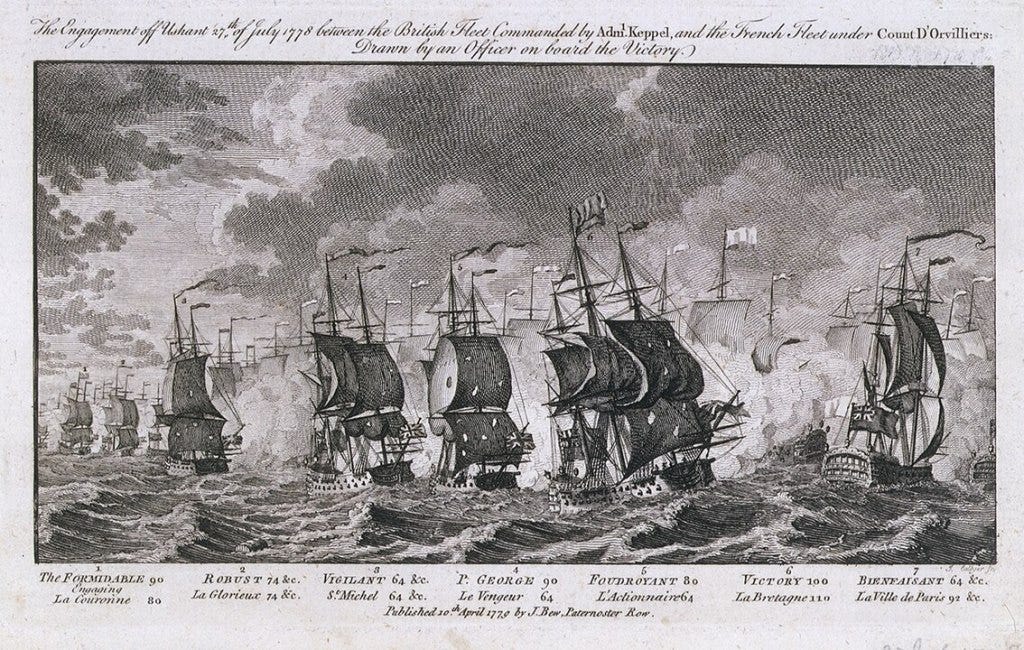One of my first cousins seven times removed was the Royal Navy officer and politician, Admiral Sir Hugh Palliser, 1st Baronet (1723 – 1796).
Hugh Palliser was born in 1723 at Kirk Deighton, in the West Riding of Yorkshire (now in North Yorkshire). His father, also called Hugh, was an army officer. When in 1727 their parents died, Hugh and his four sisters were sent to be raised by relatives of their mother, Mary (Robinson) Palliser (1695-1727).
In 1735, at the age of twelve, Hugh entered the navy as a midshipman on HMS Aldborough, a twenty-gun sixth-rater, commanded by his uncle Nicholas Robinson. He was appointed a lieutenant in 1741 and a captain in 1746.
By 1755 Hugh Palliser had command of his own vessel, the 58-gun HMS Eagle. This is the ship in which James Cook began his career in the Royal Navy. In it Cook served from 1755 to 1757 as able seaman, master’s mate and bosun.
During the seven years’ war Palliser fought under Admiral George Anson and later Admiral Charles Saunders. In 1759 he tookk part in the successful British capture of Quebec City; Palliser commanded the seamen who landed and took possession of Lower Town.

From 1764 to 1769 he was Governor of Newfoundland. In 1770 Palliser, now Commodore, was appointed Comptroller of the Navy, and elected an elder brother of the Trinity House. (Trinity House oversees British lighthouses and provides general expertise to the government on naval matters.) As comptroller of the navy Palliser was instrumental in promoting scientific and exploratory schemes, actively sponsoring his own protégé, James Cook.
In 1773 Palliser was made Baronet with a special remainder in the grant of the baronetage “failing heirs male of his body, to his sister’s son, George Robinson Walters“.
In 1774 he was elected to Parliament for the Borough of Scarborough.
On 31 March 1775 he was promoted to rear-admiral, thereby achieving flag
rank. In April 1775 he joined the Board of Admiralty as First Naval Lord and Lieutenant-General of Marines.
In 1778 he was promoted Vice-Admiral of the Blue and appointed to the western squadron under Admiral Augustus Keppel. This ended badly. On 27 July 1778 the Channel Fleet fought an inconclusive battle with the French fleet off Ushant. No ships were lost on either side, and some newspapers sympathetic to Keppel and critical of Palliser accused Palliser of inaction during the battle, ruining the chance of a victory.

Palliser asked Keppel for a public vindication of his actions. This Keppel refused to provide. In December 1778 Keppel accused Palliser in the House of Commons of disobeying commands. In response Palliser demanded that Keppel be court-martialed. In February 1779 Keppel was honourably acquitted. Palliser was portrayed as the guilty party and his house in Pall Mall was gutted by a mob and his effigy burned.
Palliser resigned his appointments, including his Admiralty seat, and withdrew from parliament. In February 1779 in an attempt to regain some of his lost prestige he applied for a court martial on himself. He was acquitted, in controversial circumstances. It was said that the ministry had ordered all the officers opposed to him to sea, recalling those who might support at the court martial. (One of those who gave evidence was his nephew and heir, George Robinson Walters.)
Palliser’s active naval career was now effectively at an end, though in September 1787 he rose automatically to become an admiral. His only new appointment was in 1780 as a governor of Greenwich Hospital, home of Royal Navy pensioners.
It is suggested that Palliser had been manipulated by the first lord of the Admiralty, Lord Sandwich, a Tory and member of the administration of Lord North. Sandwich, it is said, used Palliser as a tool to attack Keppel, a Whig.

In the 1770s Hugh Palliser purchased The Vache, an estate in Buckinghamshire, near Chalfont St Giles.
Palliser was a long-standing patron of James Cook, and after Cook’s death in 1779 he erected a monument honouring Cook in the grounds of his estate.
In 1791 Palliser made his will, a long document, which mentions many relatives. Though he never married he had an affair with a woman named Anne Thomas. In his will Palliser recognised their illegitimate son George and left him the La Vache estate. The baronetcy passed to the son of his nephew George Robinson Walters. He also left a bequest to the son of Dorothea Weston nee Orfeur and mentioned another son in a codicil. He was not however consistent in recognising his relatives and none of the children of Catherine Cavenagh nee Orfeur, sister of Mary Walters and Dorothy Weston, benefitted.

Related posts and further reading
P is for Portobello concerning my sixth great grandfather Thomas Palliser (abt 1661 – 1756), uncle of Sir Hugh Palliser
Betham, Rev. William; The baronetage of England vol 3; Ipswich, Burrell and Bransby, 1801-1805 page 41
Cokayne, George E. Complete Baronetage, volume 5, page 167
Drummond, M. M. (1964). PALLISER, Sir Hugh, 1st Bt. (1723-96), of Chalfont St. Giles, Bucks. The History of Parliament. https://www.historyofparliamentonline.org/volume/1754-1790/member/palliser-sir-hugh-1723-96
Harrison, C. (n.d.). Sir Hugh Palliser (1721/22-1796). Three Decks. https://threedecks.org/index.php?display_type=show_crewman&id=2486
Hiscocks, R. (n.d.). Sir Hugh Palliser. More than Nelson. https://morethannelson.com/officer/sir-hugh-palliser/
Robson, J. (2009). Hugh Palliser – Cook’s second naval captain. Captain Cook Society. https://www.captaincooksociety.com/cooks-life/people/cooks-officers-and-crew-and-contemporaries/hugh-palliser-cook-s-second-naval-captain
Cavenagh, W. O. “Castletown Carne and Its Owners (Continued).” The Journal of the Royal Society of Antiquaries of Ireland, vol. 2, no. 1, 1912, pp. 34–45. JSTOR, www.jstor.org/stable/25514203.: about the Palliser family
Wikitree: Hugh Palliser (1723-1796)

